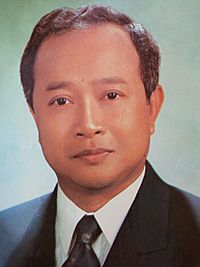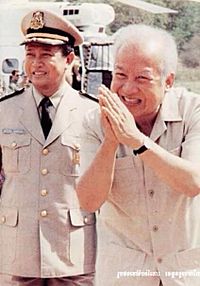Norodom Ranariddh facts for kids
Quick facts for kids
His Royal Highness
Samdech Krom Preah Norodom Ranariddh
|
|
|---|---|
| នរោត្ដម រណឫទ្ធិ | |
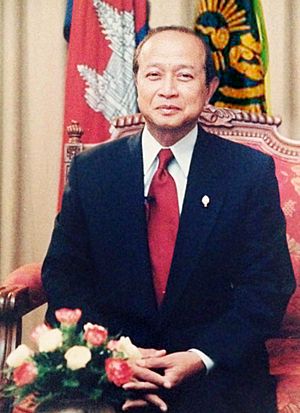
Ranariddh in 2006
|
|
| President of the National Assembly | |
| In office 25 November 1998 – 14 March 2006 |
|
| Monarch | |
| Vice President |
|
| Preceded by | Chea Sim |
| Succeeded by | Heng Samrin |
| Prime Minister of Cambodia | |
|
First Prime Minister
|
|
| In office 24 September 1993 – 6 August 1997 Serving with Hun Sen
|
|
| Monarch | Norodom Sihanouk |
| Preceded by | Himself (as sole prime minister) |
| Succeeded by | Ung Huot |
| In office 2 July 1993 – 24 September 1993 |
|
| President | Norodom Sihanouk |
| Preceded by | Hun Sen |
| Succeeded by | Himself (as First Prime Minister) |
| President of FUNCINPEC | |
| In office 19 January 2015 – 28 November 2021 |
|
| Preceded by | Norodom Arunrasmy |
| Succeeded by | Norodom Chakravuth |
| In office February 1992 – 18 October 2006 |
|
| Preceded by | Nhiek Tioulong |
| Succeeded by | Keo Puth Rasmey |
| President of the Norodom Ranariddh Party | |
| In office November 2006 – October 2008 |
|
| Preceded by | Position established |
| Succeeded by | Chhim Siek Leng |
| In office December 2010 – August 2012 |
|
| Preceded by | Chhim Siek Leng |
| Succeeded by | Pheng Heng |
| President of the Community of Royalist People's Party | |
| In office 16 March 2014 – 17 January 2015 |
|
| Preceded by | Position established |
| Succeeded by | Position abolished |
| Member of Parliament for Kampong Cham |
|
| In office 24 November 2017 – 29 July 2018 |
|
| In office 25 November 1998 – 12 December 2006 |
|
| Member of Parliament for Phnom Penh |
|
| In office 14 June 1993 – 26 July 1998 |
|
| Personal details | |
| Born | 2 January 1944 Phnom Penh, Cambodia, French Indochina |
| Died | 28 November 2021 (aged 77) Aix-en-Provence, France |
| Political party | FUNCINPEC (1983–2006; 2015–2021) |
| Other political affiliations |
|
| Spouses |
|
| Children |
|
| Parents |
|
| Alma mater | University of Provence |
| House | Norodom |
Norodom Ranariddh (Khmer: នរោត្តម រណឫទ្ធិ; 2 January 1944 – 28 November 2021) was a Cambodian prince, politician, and law professor. He was the second son of King Norodom Sihanouk of Cambodia. He was also the half-brother of the current King, Norodom Sihamoni.
Ranariddh led a royalist political party called FUNCINPEC. He served as the First Prime Minister of Cambodia from 1993 to 1997. This was after the monarchy was brought back. Later, he became the President of the National Assembly from 1998 to 2006.
He studied law in France and started his career there as a researcher and teacher. In 1983, he joined FUNCINPEC. He became its leader in 1992. When FUNCINPEC won the 1993 Cambodian general election, they formed a government with another party. Ranariddh became the First Prime Minister, sharing power with Hun Sen. As Prime Minister, he worked to bring more businesses to Cambodia. He also set up the Cambodian Development Council (CDC).
Over time, his relationship with Hun Sen became difficult. They disagreed on how to share power. In July 1997, there were fights between their groups of soldiers. This made Ranariddh leave Cambodia. He was removed from his position as First Prime Minister.
He returned to Cambodia in 1998 and led his party in the next election. After his party lost, he became the President of the National Assembly. He was once thought to be a possible future king, but he later said he was not interested. He passed away in November 2021 in France.
Contents
Early Life and Education
Ranariddh was born in Phnom Penh, Cambodia, on January 2, 1944. His father was Norodom Sihanouk, who later became King. His mother was Phat Kanhol, a ballet dancer.
He grew up mostly with his aunt and grandaunt. He went to school in Phnom Penh. He was close to his grandparents, but not as close to his father.
In 1958, Ranariddh went to a boarding school in France. He wanted to study medicine, but his grandmother encouraged him to study law. He went to the University of Paris and then the University of Provence. He earned his bachelor's and master's degrees in law.
In 1970, he returned to Cambodia and worked briefly for the Interior Ministry. When Lon Nol took power, Ranariddh lost his job. He was arrested twice but later released. In 1973, he went back to France and finished his PhD in law in 1975. He then worked as a researcher and taught law at the University of Provence.
Starting a Political Career
Joining FUNCINPEC
In 1981, Ranariddh's father, Sihanouk, started the FUNCINPEC party. At first, Ranariddh did not want to join. But in 1983, his father asked him again, and he agreed. Ranariddh moved to Bangkok, Thailand. There, he managed the party's international activities in Asia.
He became a leader in FUNCINPEC's armed forces in 1986. In 1989, he became the party's secretary-general. He also joined the Supreme National Council of Cambodia (SNC). This group helped manage Cambodia's affairs during a time of change. In 1991, he signed the 1991 Paris Peace Accords. These agreements officially ended the Cambodian–Vietnamese War. In 1992, he was elected president of FUNCINPEC.
The 1993 Elections
In 1992, the United Nations Transitional Authority in Cambodia (UNTAC) was set up to help Cambodia. Ranariddh was part of this group. He traveled between Bangkok and Phnom Penh. He worked to open FUNCINPEC offices across Cambodia.
His party faced some challenges, including attacks on its members. Some of his close friends advised him not to join the 1993 elections. However, a UNTAC leader encouraged him to run. Ranariddh decided to register the party.
During the election campaign, FUNCINPEC used images of Sihanouk. This followed a rule not to use Sihanouk's name directly. In May 1993, FUNCINPEC won about 45 percent of the votes. They secured 58 out of 120 seats in parliament. However, the Cambodian People's Party (CPP) did not accept the results. They claimed there was cheating.
After some discussions and threats of conflict, Ranariddh agreed to work with the CPP. They decided to have two prime ministers. On June 14, Sihanouk became the Head of State. Ranariddh and Hun Sen became co-Prime Ministers in a temporary government. A new constitution was written. On September 24, 1993, Sihanouk became King again. In the new government, Ranariddh was named the First Prime Minister, and Hun Sen was the Second Prime Minister.
Sharing Power as Prime Minister (1993–1997)
Working with the CPP
Even though Ranariddh was the First Prime Minister, Hun Sen often had more power. At first, Ranariddh and Hun Sen worked well together. They agreed on many important decisions. For example, in 1993, they decided that Cambodia should join the International Organization of the Francophonie. This group promotes French language and culture.
Ranariddh admired countries like Singapore and Malaysia. He believed their economic systems could help Cambodia grow. He wanted to bring more foreign businesses to Cambodia. In 1994, he created the Cambodian Development Council (CDC) to encourage investments. He was the chairperson of this council.
Many Malaysian businesses invested in Cambodia. They worked on projects like building power plants and hotels. Ranariddh approved many of these projects. He also dealt with the logging industry. The government tried to control timber exports, which were a big source of money. Ranariddh and Hun Sen sometimes allowed timber to be exported temporarily.
Growing Disagreements
In 1994, Ranariddh and Hun Sen removed Sam Rainsy as Finance Minister. Rainsy had been looking into government transparency, which made both prime ministers uncomfortable. This led to other officials resigning.
By 1996, the relationship between Ranariddh and Hun Sen became very tense. Ranariddh felt that the CPP was taking too much power. He said that FUNCINPEC ministers felt like "puppets." He also complained about delays in projects and appointments.
Ranariddh tried to make alliances with other political parties. He formed the "National United Front" (NUF) in January 1997. He wanted to lead this group against the CPP in the next elections. The CPP formed its own alliance in response.
Ranariddh also tried to get support from some former Khmer Rouge leaders. This made Hun Sen very angry. In June 1997, there were small fights between Ranariddh's and Hun Sen's bodyguards. Hun Sen then stopped working with Ranariddh.
On July 3, 1997, Ranariddh left Cambodia. The next day, fighting broke out between soldiers loyal to FUNCINPEC and those loyal to the CPP. Ranariddh's forces were defeated. This led to him being removed from his position as First Prime Minister.
Leading FUNCINPEC (1997–2006)
Exile and Return
After the fighting in July 1997, Ranariddh was effectively removed from power. The Cambodian government called him a "criminal" and a "traitor." Ranariddh traveled to other countries to seek help. In his absence, another FUNCINPEC member, Ung Huot, was chosen to replace him as First Prime Minister.
In September 1997, the UN helped arrange talks between Ranariddh and Hun Sen. They discussed the return of FUNCINPEC politicians and preparing for the 1998 Cambodian general election. Ranariddh faced legal challenges related to his political activities. However, he received a pardon from King Sihanouk. This allowed him to return to Cambodia in March 1998 to lead FUNCINPEC's election campaign.
In the July 1998 elections, FUNCINPEC came in second place. The CPP won the most seats. Both Ranariddh and Sam Rainsy, another opposition leader, claimed the election was unfair. They organized protests. King Sihanouk stepped in to help resolve the situation.
President of the National Assembly
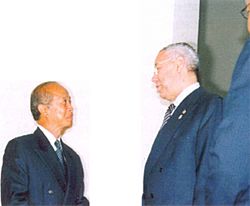
Ranariddh returned to Cambodia in November 1998. He negotiated with Hun Sen and other leaders. They agreed that FUNCINPEC would get the National Assembly presidency. On November 25, 1998, Ranariddh became the President of the National Assembly. This meant he was in charge of the country's main law-making body.
In this role, Ranariddh worked to bring FUNCINPEC soldiers back into the national army. He also helped improve relations with Vietnam. He encouraged cooperation between Cambodian and Vietnamese political leaders. He also tried to make FUNCINPEC work more closely with the CPP.
However, some FUNCINPEC politicians were unhappy with Ranariddh's leadership. In 2002, the party did not do well in local elections. This caused more disagreements within the party. Some members left to form new parties. Ranariddh worried that FUNCINPEC would not do well in the 2003 general elections.
In the July 2003 elections, FUNCINPEC's support dropped. Ranariddh and Sam Rainsy again claimed the election was unfair. They formed a new alliance called the "Alliance of Democrats." They wanted a three-party government. After several months, Ranariddh agreed for FUNCINPEC to join the CPP as a junior partner. As part of this deal, he remained President of the National Assembly.
In March 2006, Ranariddh resigned as President of the National Assembly. He then left Cambodia to live in France. In October 2006, he was removed as president of FUNCINPEC.
Later Political Activities (2006–2021)
New Parties and Retirement
After leaving FUNCINPEC, Ranariddh formed a new party called the Norodom Ranariddh Party (NRP) in November 2006. He became its president. The National Assembly removed him as a Member of Parliament.
In March 2007, he faced legal issues and left Cambodia to avoid imprisonment. While in exile, he communicated with his party members by phone and video. He suggested that his new party merge with other opposition parties, but this did not happen.
In September 2008, King Norodom Sihamoni (who became King in 2004) gave Ranariddh a royal pardon. This allowed him to return to Cambodia without being arrested. After returning, Ranariddh said he would retire from politics. He focused on charity work and royal duties.
However, in late 2010, leaders from his old party, FUNCINPEC, asked him to return to politics. He agreed in December 2010. For a while, he tried to merge the NRP with FUNCINPEC. An agreement was made in May 2012, but it fell apart a month later. In August 2012, Ranariddh retired from politics for a second time.
Return to FUNCINPEC
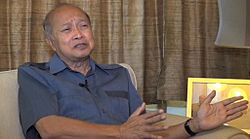
In March 2014, Ranariddh came out of retirement again. He launched a new political party called the Community of Royalist People's Party (CRPP). Some people thought he was trying to divide the opposition votes. But Ranariddh said he wanted to unite royalist supporters.
In January 2015, he dissolved the CRPP and returned to FUNCINPEC. On January 19, 2015, he was reappointed as FUNCINPEC president. He also helped create the Cambodian Royalist Youth Movement. This group aimed to get support from younger voters for FUNCINPEC.
In November 2017, he became a Member of Parliament again. This happened after another opposition party was dissolved. FUNCINPEC received many of the empty seats. However, in the 2018 Cambodian general election, FUNCINPEC did not win any seats.
Royal Connections
Awards and Appointments
In June 1993, Ranariddh received the Cambodian royal title "Sdech Krom Luong," meaning "Senior Prince." In November 1993, he was given an even higher rank, "Samdech Krom Preah," or "Leading Senior Prince." This was to recognize his efforts in bringing King Sihanouk back to the throne.
He received several awards from the palace. He was also given awards from international organizations. In December 2008, King Sihamoni appointed Ranariddh as President of the Supreme Privy Council of Cambodia. This position is similar in rank to a prime minister.
Possible King
People started discussing who would become king after Sihanouk in 1993. In a 1995 survey, 24 percent of people wanted Ranariddh to be the next king. King Sihanouk himself encouraged Ranariddh to succeed him. However, Sihanouk also worried about who would lead FUNCINPEC if Ranariddh became king.
Sihamoni, Ranariddh's half-brother, was also considered a possible candidate. Sihamoni was not involved in politics, which made him popular with some leaders.
Ranariddh initially said he did not want to be king. He felt his personality was not suitable for the throne. But by 1999, he seemed more open to the idea. In 2001, he decided to focus on his political career instead of the throne. In October 2004, the royal council met to choose Sihanouk's successor. Ranariddh was part of the council that chose Norodom Sihamoni to be the next king.
Personal Life and Passing
Ranariddh looked a lot like his father, King Sihanouk. He had similar facial features, a high-pitched voice, and mannerisms. People often noticed this resemblance. He used his likeness to his father to gain support for his party during elections.
Ranariddh spoke Khmer, French, and English very well. He also had both Cambodian and French citizenship. He enjoyed music and movies. In 2002, he even produced and directed a film called Raja Bori.
On November 28, 2021, Norodom Ranariddh passed away in France at the age of 77.
Family Life
Ranariddh had 12 half-siblings from his father. His only full sibling was Norodom Buppha Devi, who became a ballet dancer like their mother.
Ranariddh met his first wife, Eng Marie, in 1968. They married in September 1968 and had three children: Chakravuth, Sihariddh, and Rattana Devi. They separated, and their divorce was finalized in 2010.
Ranariddh had two sons with Ouk Phalla: Sothearidh and Ranavong. Ouk Phalla was a classical dancer. They met when Ranariddh was making his film.
On June 17, 2018, Ranariddh and Ouk Phalla were in a serious car accident. Ouk Phalla died from her injuries. Ranariddh was also badly hurt and went to Paris for medical treatment.
Images for kids
See also
 In Spanish: Norodom Ranariddh para niños
In Spanish: Norodom Ranariddh para niños



